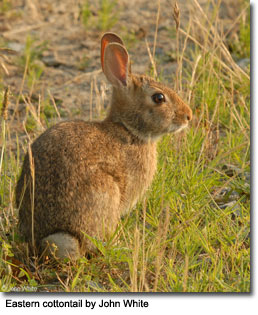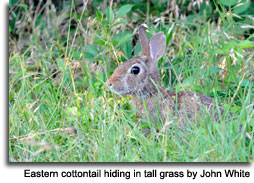Eastern Cottontail
(Sylvilagus floridanus)
 Description & Range:
Description & Range:
Cottontail rabbits are small animals with speckled brown fur, which fades to
white underneath. They have big eyes, long ears, and large hind legs and feet.
Seldom weighing more than three pounds or exceeding 15 inches in length, they
are named after their tails - a small tuft of white fur.
Cottontails are found throughout Maryland on farms, in orchards, and in
backyards. They are abundant in all counties, but are usually more plentiful in
Piedmont and mountainous areas. Fewer reside in parts of the Eastern Shore where
large amounts of seasonally wet areas exist. Cottontails can be found throughout
eastern and the southern to central parts of the United States. Eastern
cottontails can also be found in parts of central America and the northern
portion of South America.
Habitat:
Cottontails reside in areas with clearings, fields and shrublands. Many times,
these common rabbits can also be found in backyards and more urban settings.
Diet:
Cottontails are almost exclusively vegetarian as they use a wide variety of
plants for food. During summer, they feed on tender green shoots, sprouts,
leaves, clover, sedges and grasses. In the fall, herbaceous plants such as
ragweed and crabgrass are utilized. Winter foods include buds, stems, and tips
of low growing shrubs, vines and tree bark. Cottontails get their water from the
plants they eat.
Reproduction:
Cottontails become sexually mature at 1, and females can have up to 5 litters of young per year! Litter sizes range from 3-8 babies at a time, and the young are
born after 30 days of gestation. In contrast to hares, young rabbits are born
hairless and helpless and are completely dependent on the mothers until they are
2 weeks old. After this time, the young can forage and fend for themselves.
Behavior:
Surpri singly, eastern cottontails are very territorial. When startled, they will run in a zig-zag pattern up to 18 miles per hour! During the day, most
cottontails hide in dense cover. Cottontails do not dig burrows, rather they
tend to use shallow, scratched-out depressions in grass to rest within.
Sometimes during extremely inclement weather, cottontails will seek shelter in
abandoned groundhog dens.
singly, eastern cottontails are very territorial. When startled, they will run in a zig-zag pattern up to 18 miles per hour! During the day, most
cottontails hide in dense cover. Cottontails do not dig burrows, rather they
tend to use shallow, scratched-out depressions in grass to rest within.
Sometimes during extremely inclement weather, cottontails will seek shelter in
abandoned groundhog dens.
Eastern cottontails are crepuscular- meaning that they are most active at dawn
and dusk. They are also active throughout the year.
Management:
Cottontail rabbits are managed as small game species in Maryland. Click here to find out
more information on game management.